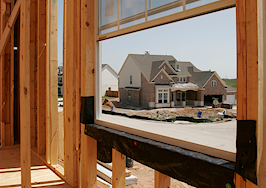- An analysis by NAR and PwC shows that non-homeowners would see tax decreases, while most homeowners would see increases.
- NAR and PwC estimate that increasing the cost of owning a home and the opportunity cost of home equity will lead to 10-percent home price reductions in the short term.
When President Donald Trump released his tax reform plan in April, everyone was scrambling to figure out if it was good, bad or neutral. It’s not an easy question to parse — we all have different household configurations with different incomes and living situations, so trying to figure out who’s spending more and less requires understanding a variety of influences and factors and bringing them all together.
That’s what the National Association of Realtors (NAR) commissioned PricewaterhouseCoopers (PwC) to do, and today the companies released the “Impact of Tax Reform on Owner-Occupied Housing,” a report that used the “Better Way for Tax Reform” blueprint to show how suggested changes to the tax law could affect citizens in different income groups.
The “Better Way” blueprint is very similar (though much more detailed) than the proposed tax document released by the Trump administration, so using the blueprint as a jumping-off point can give us a good idea of how taxes could change for homeowners and renters with different income levels.
“Tax reform and lower rates are worthy goals, but only if we can achieve them in a fiscally responsible way,” said NAR president William E. Brown in a statement. “Balancing tax reform on the backs of homeowners isn’t an option.
“A tax reform proposal that hikes taxes for homeowners is a raw deal, and consumers know it,” he added. “Leaders in Washington who are driving tax reform have shown every indication that they have the best of intentions, and we’re hopeful they’ll consider our study as this process plays out in the months ahead.”
What could happen to homeowners?
NAR has been adamant that the proposed tax reform will not be good for homeowners — the association even made tax reform one of its three main legislative talking points this year at its annual legislative meetings.
The research indicates why NAR is making tax reform a priority. NAR and PwC found that:
- Homeowners with adjusted gross incomes (AGIs) between $50,000 and $200,000 (considered “middle income”) would see their taxes rise by an average of $815; non-homeowners in the same income bracket would see a tax reduction of $516, and taxpayers whose AGI is below $50,000 would see an average tax reduction of less than $100.
- Homeowners with AGIs between $30,000 and $40,000 would also see a small tax increase.
- On a per-return basis, taxpayers with AGI under $50,000 would see average tax reductions of less than $100, and taxpayers with AGI over $200,000 would see average tax decreases of more than $15,000.
- Non-homeowners across all income categories would, on average, see their taxes decrease.
- Home values could fall by as much as 10 percent in the near term.
- Taxpayers (including both homeowners and non-homeowners) with AGIs between $75,000 and $250,000 would pay higher income taxes on average. Other income categories would see income tax reductions.
- On average, households with mortgage balances between $100,000 and $500,000 would see income tax increases.
- Households with mortgage balances more than $500,000 would see a net decrease in tax liability.
PwC and NAR estimate that in 2018, an estimated 83 percent of personal income taxes will come from homeowners — which is one big reason why NAR is concerned that the tax reform might place an unfair burden on homeowners.
Back up: What would the proposed plan change, anyway?
NAR and PwC analyzed “an illustrative comprehensive tax reform option that would lower and consolidate marginal tax rates to three rates with a top rate of 33 percent, double the standard deduction, eliminate all itemized deductions other than charitable contributions and mortgage interest, eliminate personal exemptions, eliminate the Alternative Minimum Tax, and cap the tax rate on pass-through business income at 25 percent.” All of these changes were proposed in the “Better Way” blueprint and can also be found in Trump’s tax reform proposal.
Current 2016 standard deduction
| For singles | For heads of household | Married filing jointly |
| $6,300 | $9,300 | $12,600 |
Proposed standard deduction
| For singles | For heads of household | Married filing jointly |
| $12,000 | $18,000 | $24,000 |
If the mortgage interest deduction (MID) is still intact, then what’s the big deal? NAR and PwC say it has to do with the increased standard deduction and the elimination of state and local property tax deductions.
The companies project that 35.4 million households will claim the MID in 2018, and 13.6 million (38 percent) of those households will have an outstanding loan of between $100,000 and $200,000. They also estimate that 40.7 million taxpayers will report itemized property tax deductions. “The majority of these deductions, or 70 percent in 2018, are estimated to be claimed by taxpayers with AGI between $50,000 and $200,000,” says the report.
Under tax reform, however, “only a subset of households would continue to deduct mortgage interest.”
PwC and NAR estimate that 6 million taxpayers (4.1 percent of all filers) would use the MID compared to 35 million (23.1 percent of all filers). Only about 7 million taxpayers (4.7 percent) would take any itemized deductions, compared to 46 million today (29.7 percent).
“For many homeowners that currently benefit from the mortgage interest deduction, the elimination of other itemized deductions and personal exemptions would cause their taxes to rise, even if they elected to take the increased standard deduction,” said NAR in a statement about the report. “For others, the elimination of the state and local tax deduction alone would result in higher federal income taxes.”
What’s the breakdown on who’s affected and how?
In general, the proposed tax plan would be good for non-homeowners and for all households with AGIs either below $75,000 per year or above $250,000 per year. Other groups, however, will probably be paying more in taxes.
Homeowners with an AGI between $50,000 and $200,000 could be hit hardest. According to PwC and NAR, “the mortgage interest share of the total value of itemized deductions is the highest for taxpayers with AGI between $50,000 and $200,000, for whom it ranges between 29 percent and 30 percent on average.”
And that will, in turn, have an effect on the desire or ability for many Americans to own a home, according to PwC and NAR.
“The after-tax cost of homeownership will increase while the opportunity cost of home equity (relative to alternative investments) will rise,” states the report. “These factors will lead to a decline in housing prices in the short run as housing becomes a less attractive investment.” PwC estimates that drop at 10.2 percent in the short term, acknowledging that long-term effects could be smaller.
“The ultimate price response depends on by how much the stock of housing changes in response to the reduced housing demand,” noted PwC and NAR. “If the long-run supply of owner-occupied housing is perfectly elastic, the supply of housing would decrease by enough to meet the lower demand and the price of owner-occupied housing would rise back to its original level. This adjustment could take several years.
“If the long-run supply of owner-occupied housing is less elastic, a decrease in price could persist into the future,” the companies added.
Caveats and what-ifs
The NAR and PwC study does not incorporate some elements of potential tax reform.
For example, the analysis looked at a reduction in pass-through tax rates, but it doesn’t include other business tax changes. “Households are generally believed to bear the corporate tax as owners of businesses and workers at businesses. As a result, business tax reductions would impact the overall tax burden of households and their demand for housing,” stated the companies in the report.
The report also acknowledges that there could be big, sweeping changes in the economy caused by tax reform — such as changes to interest rates and the size of the overall economy. “Interest rates under current law likely reflect elements of the tax code, and reform could lead to lower interest rates,” noted the report. “Alternatively, if tax reform leads to increased federal budget deficits or more rapid economic growth, interest rates could rise.”
And as we’ve all learned by now, interest rates affect who’s buying, selling and refinancing, so they don’t exist in a vacuum.
There could be changes in taxpayer behavior, too. “While we have incorporated certain behavioral changes, broader impacts like household consumption decisions and financing decisions would impact tax burdens and housing demand,” stated NAR and PwC.
And the companies noted that “other supply-side reactions to tax reform, such as changes in the level of economic activity in the residential real estate sector, have not been incorporated.”
Jamie Gregory, deputy chief lobbyist at NAR, told Inman earlier in May that looking at the past can give us a window to the future.
“If you want to learn from the 1986 Tax Reform Act, which everyone seems to be pointing to — the ’86 tax act took the top business tax rate from 39.6 percent to 28 percent,” Gregory noted.
“Three years later, at the big budget summit held out at Andrews Air Force Base, under George Bush 41, the rate went up to 33 percent. Then, later, under Clinton, it went back to 39.6 percent.
“So I guess the point is: You can’t bind future Congresses,” he added. “You could do away with all these incentives and the economic benefits of homeownership all in the name of lowering the rates — but once the rates go back up, the MID and state and local deductions aren’t coming back. It would be a double-whammy for homeowners.”













